Navigating by spokes in the Mandelbrot set
In my previous post Preperiodic Mandelbrot set Newton basins I was exploring convergence to preperiodic points. I also scribbled a lot on paper, and found that most of the points I was looking for had some interesting relationships between their external angles, especially when expressed as a preperiodic binary expansion.
The notation I used in the images is roughly
. pre [ rep ] ( per ) . pre rep rep rep ... rep per per per per per ...
where per is the periodic part, rep is a finitely repeated section and pre is an initial prefix - so the preperiodic part is .pre[rep].
The general idea is that each hub of spokes has external angles between each pair of spokes, and each spoke has a tip. When you move to another hub closer to the tip, all these external angles must get closer to the external angle of the tip. So the tip is a limit point of hubs, and it turns out that about the simplest possible way to transform external angles towards the tip is actually the way it seems to work.
Spokes and tips
The external angles of the spokes at the tip of the antenna of the bulb with internal angle p/q attached to the root cardioid can be found using an algorithm described in
Geometry of the Antennas in the Mandelbrot Set
by R L Devaney and M Moreno-Rocha, April 11, 2000
Another related paper describing external angles in the main antenna is
Operating with external arguments in the Mandelbrot set antenna
by G Pastor, M Romera, G Alvarez and F Montoya, December 16, 2004
Angled internal addresses are described in
Internal addresses in the Mandelbrot set and Galois groups of polynomials
by Dierk Schleicher, June 11, 2012
For example, the external angles of the spokes at the 2/5 bulb are
.01001(01010) .01001(10010) .01001(10100) .01010(00101) .01010(01001)
The tip of each spoke is the longest matching prefix of neighbouring angles, with 1 appended:
.01001(01010) .01001 1 .01001(10010) .01001 101 .01001(10100) .0101 .01010(00101) .01010 01 .01010(01001)
The widest spoke has the shortest binary representation.
The widest spoke
Moving along the widest spoke repeats the last preperiodic digit:
Start
.01001(01010) .01001(10010) .01001(10100) .01010(00101) .01010(01001)
One step towards tip
.010011(01010) .010011(10010) .010011(10100) .010100(00101) .010100(01001)
Two steps towards tip
.0100111(01010) .0100111(10010) .0100111(10100) .0101000(00101) .0101000(01001)
Other spokes
Moving along any other spoke replaces the preperiodic digits with a modification of the tip - replace the final 1 with 01 for angles below the widest tip and with 10 for angles above the widest tip:
Tip .010011
.0100101(01010) .0100101(10010) .0100101(10100) .0100110(00101) .0100110(01001)
Tip .01001101
.010011001(01010) .010011001(10010) .010011001(10100) .010011010(00101) .010011010(01001)
Tip .0101001
.01010001(01010) .01010001(10010) .01010001(10100) .01010010(00101) .01010010(01001)
Path notation
Labelling the spokes 1,2,3,4 in decreasing width order, paths through the tree of spokes might look like:
2/5*11123333112224423
Which has external angles:
.0100111110010010010001110101011001100110001(01010) .0100111110010010010001110101011001100110001(10010) .0100111110010010010001110101011001100110001(10100) .0100111110010010010001110101011001100110010(00101) .0100111110010010010001110101011001100110010(01001)
tracing external rays to hub and spoke tips give viewing parameters
-0.634134215222797 + 0.686611419636078 i @ 1e-12
which looks like
The largest (lowest period) island after a spoke path has an angled internal address related to the path, the final +1 is because the largest island after a spoke path is always in the widest branch:
2/5*11123333112224423 1 2/5 5 (5+1) (5+1+1) (5+1+1+1) (5+1+1+1+2) (5+1+1+1+2+3) ... (5+1+1+...+2+3+1) 1 2/5 5 6 7 8 10 13 16 19 22 23 24 26 28 30 34 38 40 43 44
This island's external angles are the first 44 digits of the external angles of the widest spoke:
.(01001111100100100100011101010110011001100011) .(01001111100100100100011101010110011001100100)
numerical algorithms give viewing parameters
-0.63413421522307309166332840960 + 0.68661141963581069380394003021 i @ 3.35e-24
which looks like
A final example
spoke path
1/3*[1828]2 1/3*11111111222222221111111122222222
leads to a hub with external angles
.001111111110101010101010101111111110101010101010101(010) .001111111110101010101010101111111110101010101010101(100) .001111111110101010101010101111111110101010101010110(001)
tracing external rays to hub and spoke tips give viewing parameters
-0.22817920780250860271229 + 1.11515676722969926888287 i @ 3.32e-21
which looks like
the next largest island has period
52 = 3 + (8*1 + 8*2)*2 + 1
and the external angles made by repeating the first 52 digits of each external angle corresponding to the widest spoke are
.(0011111111101010101010101011111111101010101010101011) .(0011111111101010101010101011111111101010101010101100)
numerical algorithms give viewing parameters
-0.22817920780250860271129306628202459167994 + 1.11515676722969926888221122588497247465766 i @ 2.22e-41
which looks like




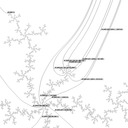
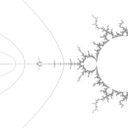
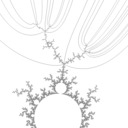
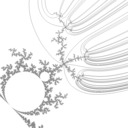
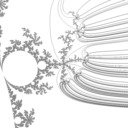
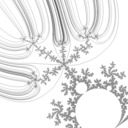
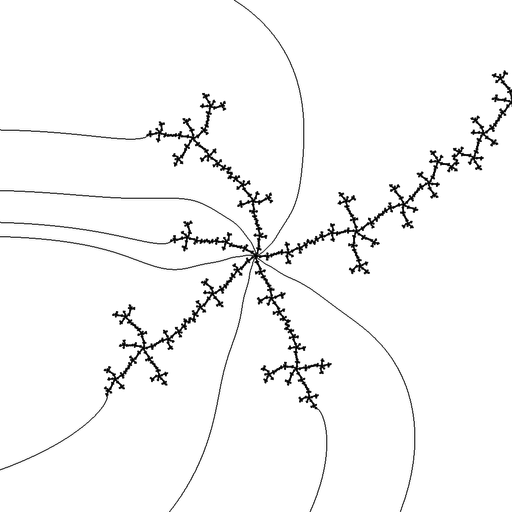
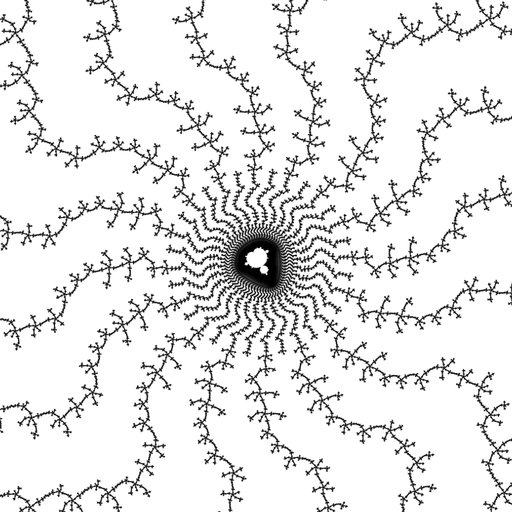
![Mandelbrot set hub 1/3*[1^8 2^8]^2](2013-02-01_hub_1-3__1x8_2x8_x2_small.png)
![Mandelbrot set island 1/3*[1^8 2^8]^2a](2013-02-01_island_1-3__1x8_2x8_x2_a_small.png)